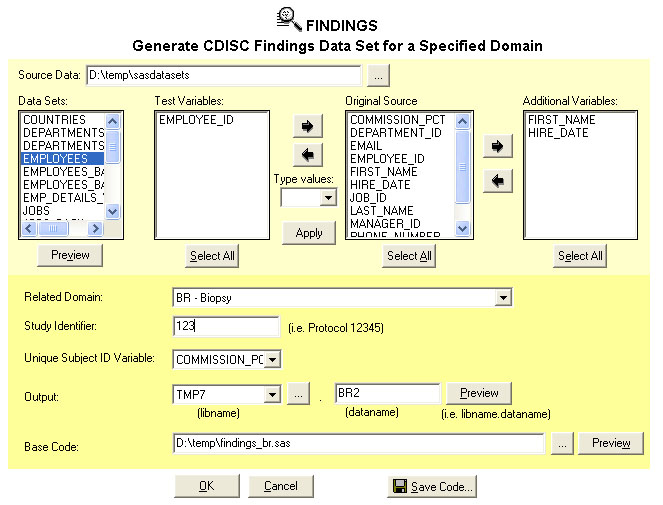|
Overview
There are three different types of domain classes which includes:
interventions, events and findings. The Findings class captures the
observations resulting from planned evaluations to address specific
questions such as observations made during a physical examination,
laboratory tests, ECG testing, and sets of individual questions listed on
questionnaires. It usually contains variables that are refered to as
a test variable such as a test for vital signs. And then there are
other accompanying additional variables. The transposition of for
this "findings" data structure can be applied using the FINDINGS tool
which is found as one of the tools from CDISC builder.
FINDINGS
Options
The FINDINGS screen allows you to select the data and associated
variables and options for the transpose and create your findings data. The data flow
for this tool is shown here.
|
Source Data |
 |
CDISC Builder
FINDINGS |
 |
Findings
data domain structure |
|

The options available for
selecting data and options for FINDINGS are:
- Source Data - This is the
location of the dataset that is going to be used to create the Findings
domain data.
- Preview - A preview of the
first 100 observations of the data is presented.
- Test Variables - Variables that
captures the test value of a particular findings.
- Original Source Variables - All
the variables found in the source dataset that is selected.
- Additional Variables - Other
variables that is going to be used to create the findings dataset that
is not a test variable.
- Related Domain - The related
CDISC domain. The list will show the entire findings domain that you
can select from.
- Study Identifier - The name of
the study or protocol number.
- Unique Subject ID Variable -
The variable from the source data that contains values for the subject
ID.
- Output - The new dataset that
is going to be created which contains the findings domain data.
- Base Code - This is an optional
SAS base code that can be produced to be used to generate the findings
domain CDISC data.
- Save Code - The code saved in
this location will contain a macro call capturing all the options that
has been selected. This can therefore be executed independent from
this interface as a SAS program.
 |
The options for
the findings data structure is very specific for each domain. It
is therefore only possible to define transformation for a specific
findings domain from one source data. If you require including
multiple source datasets for one findings domain data structure, you
would need to generate the base code and modify the program as a
custom program. |
|